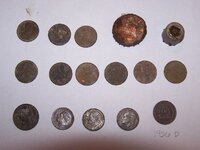Today I spent about an hour at a very old park I have been driving past, decided to try my hand at using my probe to find and pull the coins, it seemed to work OK for the shallow ones but the deeper ones were hard to locate (a lot of rocks). It took a lot of time to do it this way, Any suggestions ?
?
anyway got small amount of clad and one keeper...1956 D...
 ?
?anyway got small amount of clad and one keeper...1956 D...
Attachments
Upvote
0




 trk5capt...
trk5capt... - that was enough for me. Now I dig 'em all, except in well groomed grass. Here in Oregon we are lucky (?) that it rains all the time. You will never see a brown spot from me, lol..... If you have to, only dig when the conditions are right. Late fall through early spring are best, if you can stand the cold.
- that was enough for me. Now I dig 'em all, except in well groomed grass. Here in Oregon we are lucky (?) that it rains all the time. You will never see a brown spot from me, lol..... If you have to, only dig when the conditions are right. Late fall through early spring are best, if you can stand the cold. 


